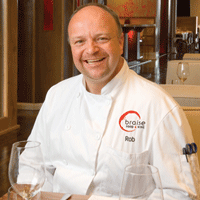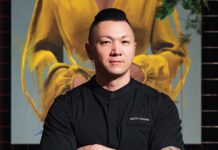Pastry chef Robert Howland infuses upscale treats with unique ingredients, care and creativity
Robert Howland thrives on challenges. While some chefs may scoff at his idea to create a serpentine chocolate sculpture, he goes to work with such tenacity his edible art not only works — it wins awards. If there’s one thing the perfectionist pastry chef at London, Ont.’s Braise restaurant emphasizes, it’s that the more involved and creative the baking, the more exciting the work.
“I just prefer the process,” says the 43-year-old Kingston, Ont., native when asked about choosing puff pastries and lemon tarts over prime rib and Atlantic salmon. “I think it had more to do with the fact I always liked baking more than cooking, and I already knew how to cook.”
Howland never had to mull over whether or not to make the leap from entrée to dessert; he simply decided to take his affinity for sweet treats to a professional level when his fascination with academia — he previously worked at the Kingston Board of Education with hearing-impaired students — gave way to an interest in pastry arts.
“When I worked at the school board we had a lunch club, where someone would bring lunch for everyone every Friday,” begins How-land. “I just came up with the idea to use cheesecake batter and pecan pie pilling. I put the filling in a pot, layered it in cylinders with parchment paper and baked it with the cheesecake batter. The reaction I got from the staff was astounding to me. They were so blown away by the effort, and that really affected me.”
Howland’s journey into professional kitchens began when he enrolled in a pastry program at the Culinary Institute of Canada in Charlottetown in 2002 and became the school’s pastry chef shortly after, in 2003. From there, he went on to create sweet concoctions at the Crowbush Golf and Beach Resort in P.E.I. and later at the Cambridge, Ont., hotspot Langdon Hall.
The challenging art (and science) of creating perfect pastry requires patience, timing and, above all, exceptionally stringent attention to detail. “Take a lemon tart,” Howland begins confidently. “It’s very technique heavy. The filling has to be made and set a certain way; if it gets overcooked it cracks, and if it’s undercooked it’s eggy. The crust has to be a certain darkness; the filling has to be bright yellow, shiny and moist. You need to know what’s happening inside the tart.”
Howland’s ascent from student to pastry master was swift, largely because he masterfully manipulates ingredients to create shapes, textures and flavours that are unfamiliar, visually stimulating and delicious to boot. And, when it comes time to be creative, Howland never shies away from taking risks. His chocolate-dragon sculpture, for example, won a double gold medal in a CCFCC cold competition, even after colleagues said the idea couldn’t possibly work.
Most recently, his list of unusual after-dinner fare includes his well-received and uniquely flavoured ice creams, infused with unorthodox ingredients like brie and blue cheese. For Howland, a dessert goes beyond sugary icing and batter; it can include savoury and spicy elements or take on the shapes of mythical creatures. “I want desserts to be fun and whimsical,” he says. “They shouldn’t be serious. I want customers to leave with smiles on their faces.”
Photography by Steve Grimes




















